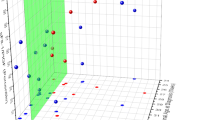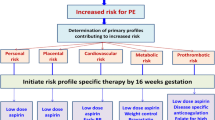Abstract
Preeclampsia (PE) is a serious pregnancy-related condition that causes severe maternal and fetal morbidity and mortality. Within the recent years, there has been an increasing focus in predicting PE at the end of the first trimester of pregnancy. In this review, literature published between 2011 and 2015 was evaluated. In a total of six biomarker algorithms, for first and early second trimester, the prediction of preeclampsia is discussed. In addition, one randomized clinical trial was included. Several algorithms were based on placental biomarkers such as pregnancy-associated plasma protein A (PAPP-A), placental growth factor (PLGF), and soluble FMS-like tyrosine kinase 1 (s-FLT-1). The algorithms containing these biomarkers showed a high prediction rate (PR) for early onset PE, ranging from 44 to 92 % at 5 % false positive rate (FPR). New biomarkers suggest an alternative model based on free HbF and the heme scavenger alpha-1-microglobulin (A1M) with a prediction rate of 69 % at an FPR of 5 %. Interestingly, this model performs well without uterine artery Doppler pulsatility index (UtAD-PI), which is an advantage particularly if the screening method were to be implemented in developing countries. The randomized clinical trial showed a clear reduction in early onset PE as well as reducing preterm PE if identified high-risk pregnancies were treated with low-dose aspirin. In conclusion, PE prediction is now possible through several prediction algorithms and prophylaxis is beneficial in high-risk cases.
Similar content being viewed by others
References
Papers of particular interest, published recently, have been highlighted as: • Of importance
Sibai BM. Preeclampsia as a cause of preterm and late preterm (near-term) births. Semin Perinatol. 2006;30(1):16–9.
Ghulmiyyah L, Sibai B. Maternal mortality from preeclampsia/eclampsia. Semin Perinatol. 2012;36(1):56–9.
WHO. The World Health Report 2005: Make every mother and child count. . 2005.
Brown MA, Lindheimer MD, de Swiet M, Van Assche A, Moutquin JM. The classification and diagnosis of the hypertensive disorders of pregnancy: statement from the international society for the study of hypertension in pregnancy (ISSHP). Hypertens Pregnancy. 2001;20(1):9–14.
Roberts JM, Redman CW. Pre-eclampsia: more than pregnancy-induced hypertension. Lancet. 1993;341(8858):1447–51.
Roberts JM, Hubel CA. The two stage model of preeclampsia: variations on the theme. Placenta. 2009;30, A:S32-7.
Redman CW, Sargent IL. Immunology of pre-eclampsia. Am J Reprod Immunol. 2010;63(6):534–43.
Redman CW. Preeclampsia: a multi-stress disorder. Rev Med Interne. 2011;32 Suppl 1:S41–4.
Hansson SR, Nääv A, Erlandsson L. Oxidative stress in preeclampsia and the role of free fetal hemoglobin. Front Physiol. 2014;5:516.
Rana S, Karumanchi SA, Lindheimer MD. Angiogenic factors in diagnosis, management, and research in preeclampsia. Hypertension. 2014;63(2):198–202.
Roberts JM, Escudero C. The placenta in preeclampsia. Hypertens Pregnancy. 2012;2(2):72–83.
Centlow M, Carninci P, Nemeth K, Mezey E, Brownstein M, Hansson SR. Placental expression profiling in preeclampsia: local overproduction of hemoglobin may drive pathological changes. Fertil Steril. 2008;90(5):1834–43.
May K, Rosenlöf L, Olsson MG, Centlow M, Morgelin M, Larsson I, et al. Perfusion of human placenta with hemoglobin introduces preeclampsia-like injuries that are prevented by alpha1-microglobulin. Placenta. 2011;32(4):323–32.
Olsson MG, Centlow M, Rutardottir S, Stenfors I, Larsson J, Hosseini-Maaf B, et al. Increased levels of cell-free hemoglobin, oxidation markers, and the antioxidative heme scavenger alpha(1)-microglobulin in preeclampsia. Free Radic Biol Med. 2010;48(2):284–91.
Olsson MG, Allhorn M, Bulow L, Hansson SR, Ley D, Olsson ML, et al. Pathological conditions involving extracellular hemoglobin: molecular mechanisms, clinical significance, and novel therapeutic opportunities for alpha(1)-microglobulin. Antioxid Redox Signal. 2012;17(5):813–46.
Anderson UD, Olsson MG, Rutardottir S, Centlow M, Kristensen KH, Isberg PE, et al. Fetal hemoglobin and alpha1-microglobulin as first- and early second-trimester predictive biomarkers for preeclampsia. Am J Obstet Gynecol. 2011;204(6):520 e1-5.
Akolekar R, Syngelaki A, Sarquis R, Zvanca M, Nicolaides KH. Prediction of early, intermediate and late pre-eclampsia from maternal factors, biophysical and biochemical markers at 11–13 weeks. Prenat Diagn. 2011;31(1):66–74.
Akolekar R, Syngelaki A, Poon L, Wright D, Nicolaides KH. Competing risks model in early screening for preeclampsia by biophysical and biochemical markers. Fetal Diagn Ther. 2013;33(1):8–15.
Kenny LC, Black MA, Poston L, Taylor R, Myers JE, Baker PN, et al. Early pregnancy prediction of preeclampsia in nulliparous women, combining clinical risk and biomarkers: the screening for pregnancy endpoints (SCOPE) international cohort study. Hypertension. 2014;64(3):644–52.
Sibai B, Dekker G, Kupferminc M. Pre-eclampsia. Lancet. 2005;365(9461):785–99.
Melchiorre K, Sharma R, Thilaganathan B. Cardiovascular implications in preeclampsia: an overview. Circulation. 2014;130(8):703–14.
Gati S, Papadakis M, Papamichael ND, Zaidi A, Sheikh N, Reed M, et al. Reversible de novo left ventricular trabeculations in pregnant women: implications for the diagnosis of left ventricular noncompaction in low-risk populations. Circulation. 2014;130(6):475–83.
Tranquilli AL, Dekker G, Magee L, Roberts JM, Sibai B, Steyn W, et al. The classification, diagnosis and management of the hypertensive disorders of pregnancy: a revised statement from the ISSHP. Hypertens Pregnancy. 2014;4:97–104. Important statement from ISSHP that redefines the definitions of severe preeclampsia.
American College of Obstetricians and Gynecologists. Task Force on Hypertension in Pregnancy, American College of Obstetricians and Gynecologists. Hypertension in pregnancy. Washington, DC: American College of Obstetricians and Gynecologists; 2013. x, 89 pages p. Important work from ACOG that sumarizes the most important knowledge of preeclampsia.
Brown MA. Pre-eclampsia: proteinuria in pre-eclampsia-does it matter any more? Nat Rev Nephrol. 2012;8(10):563–5.
Hadker N, Garg S, Costanzo C, Miller JD, Foster T, van der Helm W, et al. Financial impact of a novel pre-eclampsia diagnostic test versus standard practice: a decision-analytic modeling analysis from a UK healthcare payer perspective. J Med Econ. 2010;13(4):728–37.
Cuckle HS. Screening for pre-eclampsia—lessons from aneuploidy screening. Placenta. 2011;32(Suppl):S42–8.
Nicolaides KH. Turning the pyramid of prenatal care. Fetal Diagn Ther. 2011;29(3):183–96.
Westergaard JG, Teisner B, Grudzinskas JG. Serum PAPP-a in normal pregnancy: relationship to fetal and maternal characteristics. Arch Gynecol. 1983;233(3):211–5.
Kagan KO, Anderson JM, Anwandter G, Neksasova K, Nicolaides KH. Screening for triploidy by the risk algorithms for trisomies 21, 18 and 13 at 11 weeks to 13 weeks and 6 days of gestation. Prenat Diagn. 2008;28(13):1209–13.
Conde-Agudelo A, Bird S, Kennedy SH, Villar J, Papageorghiou AT. First- and second-trimester tests to predict stillbirth in unselected pregnant women: a systematic review and meta-analysis. BJOG. 2015;122(1):41–55.
Odibo AO. Pregnancy associated-plasma protein-a (PAPP-A) and alfa-fetoprotein (AFP) associated with placental abruption. Am J Obstet Gynecol. 2014;211(2):89–90.
Poon LC, Maiz N, Valencia C, Plasencia W, Nicolaides KH. First-trimester maternal serum pregnancy-associated plasma protein-a and pre-eclampsia. Ultrasound Obstet Gynecol. 2009;33(1):23–33.
Staff AC, Benton SJ, von Dadelszen P, Roberts JM, Taylor RN, Powers RW, et al. Redefining preeclampsia using placenta-derived biomarkers. Hypertension. 2013;61(5):932–42.
Espinoza J. The need to redefine preeclampsia. Expert Opin Med Diagn. 2012;6(4):347–57.
Young BC, Levine RJ, Karumanchi SA. Pathogenesis of preeclampsia. Annu Rev Pathol. 2010;5:173–92.
Naljayan MV, Karumanchi SA. New developments in the pathogenesis of preeclampsia. Adv Chronic Kidney Dis. 2013;20(3):265–70.
Craici IM, Wagner SJ, Weissgerber TL, Grande JP, Garovic VD. Advances in the pathophysiology of pre-eclampsia and related podocyte injury. Kidney Int. 2014;86(2):275–85.
Akolekar R, de Cruz J, Foidart JM, Munaut C, Nicolaides KH. Maternal plasma soluble fms-like tyrosine kinase-1 and free vascular endothelial growth factor at 11 to 13 weeks of gestation in preeclampsia. Prenat Diagn. 2010;30(3):191–7.
Crovetto F, Figueras F, Triunfo S, Crispi F, Rodriguez-Sureda V, Dominguez C, et al. First trimester screening for early and late preeclampsia based on maternal characteristics, biophysical parameters, and angiogenic factors. Prenat Diagn. 2015;35(2):183–91.
Parra-Cordero M, Rodrigo R, Barja P, Bosco C, Rencoret G, Sepulveda-Martinez A, et al. Prediction of early and late pre-eclampsia from maternal characteristics, uterine artery doppler and markers of vasculogenesis during first trimester of pregnancy. Ultrasound Obstet Gynecol. 2013;41(5):538–44.
Craici IM, Wagner SJ, Bailey KR, Fitz-Gibbon PD, Wood-Wentz CM, Turner ST, et al. Podocyturia predates proteinuria and clinical features of preeclampsia: longitudinal prospective study. Hypertension. 2013;61(6):1289–96.
Wright A, Wright D, Ispas CA, Poon LC, Nicolaides KH. Mean arterial pressure in the three trimesters of pregnancy: effects of maternal characteristics and medical history. Ultrasound Obstet Gynecol. 2015.
Napolitano R, Rajakulasingam R, Memmo A, Bhide A, Thilaganathan B. Uterine artery doppler screening for pre-eclampsia: comparison of the lower, mean and higher first-trimester pulsatility indices. Ultrasound Obstet Gynecol. 2011;37(5):534–7.
Velauthar L, Plana MN, Kalidindi M, Zamora J, Thilaganathan B, Illanes SE, et al. First-trimester uterine artery doppler and adverse pregnancy outcome: a meta-analysis involving 55,974 women. Ultrasound Obstet Gynecol. 2014;43(5):500–7.
Tayyar A, Guerra L, Wright A, Wright D, Nicolaides KH. Uterine artery pulsatility index in the three trimesters of pregnancy: effects of maternal characteristics and medical history. Ultrasound Obstet Gynecol. 2015.
Skrastad R, Hov G, Blaas HG, Romundstad P, Salvesen K. Risk assessment for preeclampsia in nulliparous women at 11–13 weeks gestational age: prospective evaluation of two algorithms. BJOG. 2014.
Poon LC, Stratieva V, Piras S, Piri S, Nicolaides KH. Hypertensive disorders in pregnancy: combined screening by uterine artery Doppler, blood pressure and serum PAPP-A at 11–13 weeks. Prenat Diagn. 2010;30(3):216–23.
Park F, Russo K, Williams P, Pelosi M, Puddephatt R, Walter M, et al. Prediction and prevention of early onset pre-eclampsia: the impact of aspirin after first trimester screening. Ultrasound Obstet Gynecol. 2015. The first clinical study that combines screening for preeclamsia with biomarkers and prophylactic treatment with aspirine.
Park FJ, Leung CH, Poon LC, Williams PF, Rothwell SJ, Hyett JA. Clinical evaluation of a first trimester algorithm predicting the risk of hypertensive disease of pregnancy. Aust N Z J Obstet Gynaecol. 2013;53(6):532–9.
Andermann A, Blancquaert I, Beauchamp S, Dery V. Revisiting wilson and jungner in the genomic age: a review of screening criteria over the past 40 years. Bull World Health Organ. 2008;86(4):317–9.
Anderson UD, Olsson MG, Kristensen KH, Åkerström B, Hansson SR. Review: biochemical markers to predict preeclampsia. Placenta. 2012;33:S42–7. A review article that summarizes the most important biochemichal markers of preeclamsia.
Bujold E, Roberge S, Lacasse Y, Bureau M, Audibert F, Marcoux S, et al. Prevention of preeclampsia and intrauterine growth restriction with aspirin started in early pregnancy: a meta-analysis. Obstet Gynecol. 2010;116(2 Pt 1):402–14. Metaanalysis that shows a significant benefit from aspirin in the prophylaxis of preeclampsia.
Bond S. US preventive services task force guideline supports low-dose aspirin for prevention of preeclampsia. J Midwifery Womens Health. 2015;60(2):222–3.
Åkerström B, Gram M. A1M, an extravascular tissue cleaning and housekeeping protein. Free Radic Biol Med. 2014;74:274–82.
Compliance with Ethics Guidelines
Conflict of Interest
Drs. Åkerström and Hansson declare grants from Swedish Medical Research Council and A1M Pharma; they are board members and stock holders of A1M Pharma, have a grant pending from Swedish Medical Research Council, and have a patent pending for diagnosis of preeclampsia. Drs. Anderson and Gram have no conflicts of interest.
Human and Animal Rights and Informed Consent
This article does not contain any studies with human or animal subjects performed by any of the authors.
Author information
Authors and Affiliations
Corresponding author
Additional information
This article is part of the Topical Collection on Preeclampsia
Rights and permissions
About this article
Cite this article
Anderson, U.D., Gram, M., Åkerström, B. et al. First Trimester Prediction of Preeclampsia. Curr Hypertens Rep 17, 74 (2015). https://doi.org/10.1007/s11906-015-0584-7
Published:
DOI: https://doi.org/10.1007/s11906-015-0584-7




